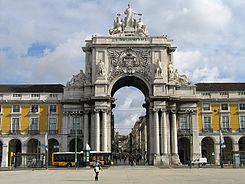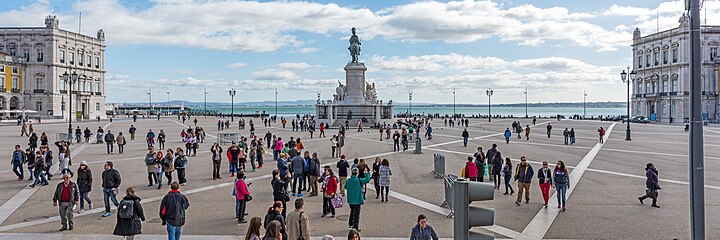Praça do Comércio
| Praça do Comércio | |
|---|---|
| Place in Lisbon | |
 The Arco da Rua Augusta represents the entrance to the Baixa Pombalina , the inner city of Lisbon built after 1755 |
|
| Basic data | |
| place | Lisbon |
| District | Santa Maria Maior |
The Praça do Comércio [ ˈpɾasɐ du kuˈmɛɾsiu ] ( Eng . Square of Commerce ) is one of the three most important squares within the Baixa Pombalina , the inner-city area of the Portuguese capital Lisbon, which was newly built due to the earthquake of 1755 , along with the Rossio and the Praça da Figueira . Located close to the capital river Tejo , the square is still known by its old name, Terreiro do Paço , [tɨ'ʁeiɾu du 'pasu] , in English about palace grounds , since the Paço da Ribeira , the royal bank lock, located there. After the earthquake, the area was given a completely new shape as part of the urban redesign initiated by the Marquis of Pombal . At the southeast end of the square is the Tejo ferry terminal Terreiro do Paço (officially Estação do Sul e Sueste ) and the Terreiro do Paço metro station .
history
The urban development on the banks of the Tagus received a considerable impetus from the decision of the Portuguese King Manuel I to build a new palace on the bank, the Paço da Ribeira . Completed in 1511, this palace, which served as the residence of the Portuguese kings for over 200 years, was framed by the great Lisbon port, shipping companies, shipyards, the Casa da Índia and other administrative buildings that marked the relationship between Portugal and its numerous colonies in Africa, America and Asia regulated.
On November 1, 1755, a devastating earthquake struck the Portuguese capital. The effects were felt in North Africa and as far as Finland. In Lisbon the quake claimed a high number of victims, the royal palace and a large part of the Lisbon lower city were destroyed by the subsequent tsunami and a huge fire. Sebastião José de Carvalho e Mello, Marquis of Pombal and at the same time Prime Minister under the reign of José I , decided on a large urban reconstruction and renovation program.
The Praça do Comércio has now been given a new, rectangular shape. The Uferpalast that was previously there was not rebuilt. The Praça do Comércio now formed the entrance to the Baixa Pombalina , the newly built city center between the Tejo, Rua Augusta and Praça da Figueira or Rossio .
The building around the 170 by 170 meter square was designed by the Portuguese architect Eugénio dos Santos in the shape of a rectangular U that opens up to the Tagus. The arcaded, four-storey buildings have two wings that end in two large towers. With this, Santos cited the no longer existing Uferpalast in order to keep it in the urban architecture. His designs were almost completely realized, only a few decorative elements were changed and the eastern tower and the arches to Rua Augusta were not completed until 1875.

With its redesign, the square was also given a new name, Praça do Comércio , in English trading center , in order to illustrate the new function of the square. The buildings around Praça do Comércio housed numerous offices for the customs and port administration, a sign of Lisbon's economic strength. The main component of the entire ensemble was the equestrian statue of Josés I , which was designed in 1775 by the artist Joaquim Machado de Castro .
The Rua Augusta , the link between the Rossio and the Praça do Comércio , opened Santos with an oversized triumphal arch, which is commonly referred to as the Arco da Rua Augusta . This archway, designed by Veríssimo da Costa , has a large clock and several allegories of the civic virtues of honor, sagacity and courage as well as statues of the Celtiberian leader Viriathus , the national hero Nuno Álvares Pereira , the Portuguese explorer Vasco da Gama and the Marquis of Pombal .
On February 1, 1908, the Praça do Comércio was the scene of the murder of Carlos of Portugal , the penultimate monarch, by the Republicans. Carlos passed in a carriage the place in which the king and the heir to the throne, his son Luís Filipe, were traveling. After two men of the later Republican Party , Alfredo Luís da Costa and Manuel Buiça , fired shots, the king died immediately as a result of the assassination, and his son died 20 minutes later. The king's younger son, Emanuel II, was the last monarch to ascend the Portuguese throne.
During the Carnation Revolution in 1974 , the Movimento das Forças Armadas used the square as an important meeting place and parade ground during the overthrow of the dictatorship of Marcelo Caetano . The Praça do Comércio was used as a car park until the 1990s . Today there is a strict parking ban there, so the square has become a popular event space.
literature
- José-Augusto França: Lisboa. Arquitectura e Urbanismo (= Ciudade de Lisboa . Volume 29 ). 3. Edition. Livros Horizonte, Lisbon 1997, ISBN 972-24-0998-0 (reprint of ICALP Lisbon 1980 edition).
Web links
- General Directorate for National Works and Monuments of Portugal (Portuguese, English, French)
Coordinates: 38 ° 42 ′ 27.9 ″ N , 9 ° 8 ′ 11 ″ W.


